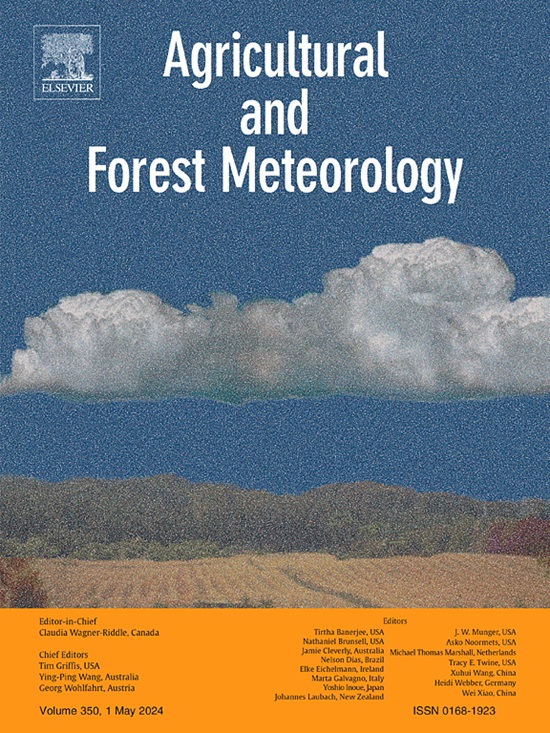Optimizing nitrogen fertilizer application in Chinese rice production under current and warming climatic scenarios
IF 5.6
1区 农林科学
Q1 AGRONOMY
引用次数: 0
Abstract
Optimizing the nitrogen (N) fertilizer use is the key to facilitating the sustainable development of agricultural systems. In this study, a DeNitrification–DeComposition model was used to analyze the effects of N fertilization on yield, profit, and reactive N losses in single-season rice production of China. The comprehensive optimum N application rate (CONR) considering the trade-off between economy and environment was calculated for each rice production county. The results showed that the high CONR values were mainly concentrated in middle and south China, like Yunnan-guizhou plateau, and Guangxi and Guangdong Provinces, where the rice yield potential is high. In addition to the Qinghai-tibet rice cultivation zone (RZ), the mean values of CONR in each RZ were mainly in the range of 150 kg N ha-1 to 200 kg N ha-1. Moreover, the 1.5 °C warming scenario with CO2 concentration up to 423 ppm increased the CONR in most RZs of China. A generalized additive model (GAM) was used to develop quick prediction models of CONR using soil, terrain, climate, and crop data as predictors. The outcomes revealed that the GAM model could well predict the CONR across China's single-season rice production counties under both current (R2 = 0.58, RRMSE = 18.3 %) and warming (R2 = 0.61, RRMSE = 18.3 %) climatic scenarios. The rice yield potential, soil clay fraction, and soil organic carbon were the most important factors affecting CONR among different RZs. The cost-effectiveness analysis showed that CONR may save 9.7 % – 9.8 % more N fertilizer use and reduce 13 % – 14.5 % more N pollutant emissions in Chinese single-season rice production than the economic optimum N rate under current and warming climatic scenarios, and the net profit is only reduced by 1.1 % – 1.3 %. This research would offer a novel strategy for rice N fertilization management across China by optimizing the economic and environmental consequences at the same time.
在当前和气候变暖情景下优化中国水稻生产中的氮肥施用量
优化氮肥使用是促进农业系统可持续发展的关键。本研究采用脱氮-脱碳模型分析了中国单季稻生产中氮肥施用对产量、利润和活性氮损失的影响。在考虑经济与环境权衡的基础上,计算了各水稻生产县的综合最佳氮肥施用量(CONR)。结果表明,CONR 值较高的地区主要集中在中南部,如云贵高原、广西和广东等水稻增产潜力较大的省份。除青藏水稻栽培区(RZ)外,各栽培区 CONR 的平均值主要在 150 kg N ha-1 至 200 kg N ha-1 之间。此外,在升温 1.5 °C、二氧化碳浓度达到 423 ppm 的情景下,中国大部分区域的 CONR 都有所增加。以土壤、地形、气候和作物数据为预测因子,利用广义相加模型(GAM)建立了CONR快速预测模型。结果表明,无论是在当前气候情景(R2 = 0.58,RRMSE = 18.3 %)还是气候变暖情景(R2 = 0.61,RRMSE = 18.3 %)下,GAM 模型都能很好地预测中国单季稻生产县的 CONR。水稻产量潜力、土壤粘度和土壤有机碳是不同区域间影响 CONR 的最重要因素。成本效益分析表明,在当前气候情景和气候变暖情景下,CONR比经济最优氮肥用量在中国单季稻生产中可节省9.7%-9.8%的氮肥用量,减少13%-14.5%的氮污染物排放,而净利润仅减少1.1%-1.3%。这项研究将为中国水稻氮肥管理提供一种新策略,同时优化经济和环境后果。
本文章由计算机程序翻译,如有差异,请以英文原文为准。
求助全文
约1分钟内获得全文
求助全文
来源期刊
CiteScore
10.30
自引率
9.70%
发文量
415
审稿时长
69 days
期刊介绍:
Agricultural and Forest Meteorology is an international journal for the publication of original articles and reviews on the inter-relationship between meteorology, agriculture, forestry, and natural ecosystems. Emphasis is on basic and applied scientific research relevant to practical problems in the field of plant and soil sciences, ecology and biogeochemistry as affected by weather as well as climate variability and change. Theoretical models should be tested against experimental data. Articles must appeal to an international audience. Special issues devoted to single topics are also published.
Typical topics include canopy micrometeorology (e.g. canopy radiation transfer, turbulence near the ground, evapotranspiration, energy balance, fluxes of trace gases), micrometeorological instrumentation (e.g., sensors for trace gases, flux measurement instruments, radiation measurement techniques), aerobiology (e.g. the dispersion of pollen, spores, insects and pesticides), biometeorology (e.g. the effect of weather and climate on plant distribution, crop yield, water-use efficiency, and plant phenology), forest-fire/weather interactions, and feedbacks from vegetation to weather and the climate system.

 求助内容:
求助内容: 应助结果提醒方式:
应助结果提醒方式:


